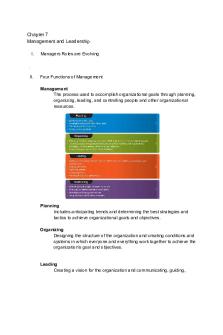Chapter 7 PDF

| Title | Chapter 7 |
|---|---|
| Course | Foundations Of Business II |
| Institution | Drexel University |
| Pages | 7 |
| File Size | 372.8 KB |
| File Type | |
| Total Downloads | 14 |
| Total Views | 177 |
Summary
Chapter 7 notes...
Description
Chapter 7 Management and Leadership I.
II.
Managers Roles are Evolving
Four Functions of Management Management The process used to accomplish organizational goals through planning, organizing, leading, and controlling people and other organizational resources.
Planning Includes anticipating trends and determining the best strategies and tactics to achieve organizational goals and objectives. Organizing Designing the structure of the organization and creating conditions and systems in which everyone and everything work together to achieve the organization's goal and objectives.
Leading Creating a vision for the organization and communicating, guiding,
training, coaching, and motivating others to achieve goals and objectives in a timely manner. Controlling Clear standards to determine whether an organization is progressing toward its goals and objectives, rewarding people for doing a good job, and taking corrective action if they are not.
III.
Planning and Decision Making Vision More than a goal, it is a broad explanation of why the organization exists and where it is trying to go. Mission Statement Outlines the organization's fundamental purposes. ● Organizations self concept ● Its philosophy ● Long term survival needs ● Customer needs ● Social Responsibilities ● Nature and product or service Goals The broad, long term accomplishments an organization wishes to attain. Objectives Specific, short term statements detailing how to achieve the organization's goals
SWOT Analysis Analyzes the organization's strengths and weaknesses, and the opportunities and threats it faces.
Strategic Planning Done by top management and determines the major goals of the organization and the policies, procedures, strategies, and resources it will need to achieve them. Tactical Planning Process of developing detailed, short term statements about what is to be done, who is to do it, and how. Operational Planning Process of setting work standards and schedules necessary to implement the company's tactical objectives. Focuses on specific supervisors, department managers, and individual employees. Contingency Planning
Process of preparing alternative courses of action the firm can use if it is primary plans don't work out. Decision Making Choosing among two or more alternatives, which sounds easier than it is. ● Define the situation ● Describe and collect needed information ● Develop alternatives ● Decide which alternative is best ● Do what is indicated ● Determine whether the decision was a good one Problem Solving Less formal than decision making and usually calls for quicker action to resolve everyday issues. Brainstorming Coming up with as many solutions as possible in a short period of time, with no censoring of ideas. PMI Listing all the pluses for a solution in one column, all the minuses in another, and the implications in a third.
IV.
Organizing Top Management Highest level, consists of the president and other key company executives, who develop strategic plans.
Middle Management General managers, division managers, and branch and plan managers Supervisory Management Directly responsible for supervising workers and evaluating their daily performance.
Technical Skills The ability to perform tasks in a specific discipline or department Human Relations Skills Communication and motivation. Conceptual Skills
Picture the organization as a whole and see the relationship among its various parts Staffing Recruiting, hiring, motivating, and retaining the best people available to accomplish the company's objectives.
V.
Leading Transparency The presentation of a company's facts and figures in a way that is clear and apparent to all stakeholders.
Autocratic Leadership Making managerial decisions without consulting others. Effective in emergencies. Participative (Democratic) Leadership Managers and employees working together to make decisions. Increases job satisfaction. Free Rein Leadership Managers set objectives and employees are free to do whatever is appropriate to accomplish those objectives. Enabling Giving workers the education and tools they need to make decisions.
Knowledge Management Finding the right information, keeping the information in a readily accessible place, and making the information know to everyone in the firm.
VI.
Controlling
External Customers Dealers, who buy products to sell to others and ultimate customers. Internal Customers Individuals and units within the firm that receive services from other individuals or units. VII....
Similar Free PDFs

Chapter 7 quiz#7
- 3 Pages

Assignment #7 Chapter 7
- 2 Pages

Chapter-7
- 7 Pages

Chapter 7
- 4 Pages

Chapter 7
- 57 Pages

Chapter 7
- 46 Pages

Chapter 7
- 7 Pages

Chapter 7
- 1 Pages

Chapter 7
- 5 Pages

Chapter 7
- 8 Pages

Chapter 7
- 34 Pages

Chapter 7
- 10 Pages

Chapter 7
- 10 Pages

Chapter 7
- 32 Pages

Chapter 7
- 46 Pages

Chapter 7
- 10 Pages
Popular Institutions
- Tinajero National High School - Annex
- Politeknik Caltex Riau
- Yokohama City University
- SGT University
- University of Al-Qadisiyah
- Divine Word College of Vigan
- Techniek College Rotterdam
- Universidade de Santiago
- Universiti Teknologi MARA Cawangan Johor Kampus Pasir Gudang
- Poltekkes Kemenkes Yogyakarta
- Baguio City National High School
- Colegio san marcos
- preparatoria uno
- Centro de Bachillerato Tecnológico Industrial y de Servicios No. 107
- Dalian Maritime University
- Quang Trung Secondary School
- Colegio Tecnológico en Informática
- Corporación Regional de Educación Superior
- Grupo CEDVA
- Dar Al Uloom University
- Centro de Estudios Preuniversitarios de la Universidad Nacional de Ingeniería
- 上智大学
- Aakash International School, Nuna Majara
- San Felipe Neri Catholic School
- Kang Chiao International School - New Taipei City
- Misamis Occidental National High School
- Institución Educativa Escuela Normal Juan Ladrilleros
- Kolehiyo ng Pantukan
- Batanes State College
- Instituto Continental
- Sekolah Menengah Kejuruan Kesehatan Kaltara (Tarakan)
- Colegio de La Inmaculada Concepcion - Cebu